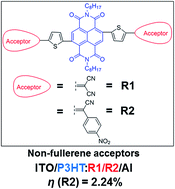Naphthalene diimide-based non-fullerene acceptors for simple, efficient, and solution-processable bulk-heterojunction devices†
Abstract
Two solution processable, non-fullerene electron acceptors, 2,2′-(((2,7-dioctyl-1,3,6,8-tetraoxo-1,2,3,6,7,8-exahydrobenzo[lmn][3,8]phenanthroline-4,9-diyl)bis(thiophene-5,2-diyl))bis(methanylylidene))dimalononitrile (R1) and (2Z,2′Z)-3,3′-((2,7-dioctyl-1,3,6,8-tetraoxo-1,2,3,6,7,8-hexahydrobenzo[lmn][3,8]phenanthroline-4,9-diyl)bis(thiophene-5,2-diyl))bis(2-(4-nitrophenyl) acrylonitrile) (R2), comprised of central naphthalene diimide and two different terminal accepting functionalities, malononitrile and 2-(4-nitrophenyl)acetonitrile, respectively, were designed and synthesised. The central and terminal accepting functionalities were connected via a mild conjugated thiophene linker. Both of the new materials (R1 and R2) displayed high thermal stability and were found to have energy levels matching those of the archetypal electron donor poly(3-hexylthiophene). A simple, solution-processable bulk-heterojunction device afforded a promising power conversion efficiency of 2.24% when R2 was used as a non-fullerene electron acceptor along with the conventional donor polymer poly(3-hexylthiophene). To the best of our knowledge, the materials reported herein are the first examples in the literature where synchronous use of such accepting blocks is demonstrated for the design and development of efficient non-fullerene electron acceptors.


 Please wait while we load your content...
Please wait while we load your content...